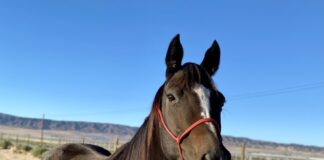An adult horse’s teeth are not all that they appear. With a full length of about four inches, much of each permanent horse tooth is hidden within the jaw. In the days of roaming pastures, continuous grazing of rough material such as dirt, grit and silicate in grass would cause a horse’s teeth to wear at a constant level. This constant wear made room for the average three to four millimeters of tooth that grows out each year.
Even under normal grazing conditions, horses’ teeth tend to develop sharp enamel points. This is because a horse’s upper jaw is naturally wider than his lower jaw. The sideways grinding motion during chewing causes points to form on the cheek side of his upper jaw molars and premolars and the tongue side of his lower jaw molars and premolars. Left alone, problems such as cuts in his cheeks and tongue, difficulty chewing and pain with a bit can result.
Fortunately, veterinarians have developed a technique to prevent this problem. Floating is the process of rasping or filing a horse’s teeth to maintain balance and free chewing motion. Frequency of floating can differ from horse to horse and should be determined by regular dental exams at least once a year. Although practices may vary, most veterinarians will sedate the horse for this procedure.
To keep horses comfortable and utilizing feed efficiently, floating should be an essential part of any equine’s overall dental maintenance.
Further Reading
Dental Issues of the Senior Horse
Recognize Your Horse’s Dental Problems






before i read this i didnt know what floating was and i didnt know how important it was. so thank you very much for writing this article
I recently had my horses teeth done and saw a major improvement in her eating and in in her performance in the ring. She was more responsive to the bit and gained some weight. I didn’t realize the importance of dental care in the horse. The dentist also let me feel the cuts in her mouth. I was sad to know she had been in pain and couldn’t say anything.
Good article. It would have been nice if it included about how often a horses teeth needed to be floated and starting what age.
Interesting and helpful, though I am curious to know at what age horse’s teeth begin to need to be floated.
good article!
Good article, but I have to agree with everyone. I would love to know the age you start floating teeth. Too bad I can’t do this myself. Would save me $75 a year.
What an informative and interesting article!
Veterinarians didn’t develop the process of floating teeth. Floating predates veterinary licensing by a couple hundred years. Only with the advent of power tools has floating become of interest to DVMs.
I want to read up on floating, so when my horses need it, I will know what they are talking about.
I wish I had the money to do my horses as needed. I want to learn to do the general floating myself.
people need to know more about equine dentistry. its often overlooked